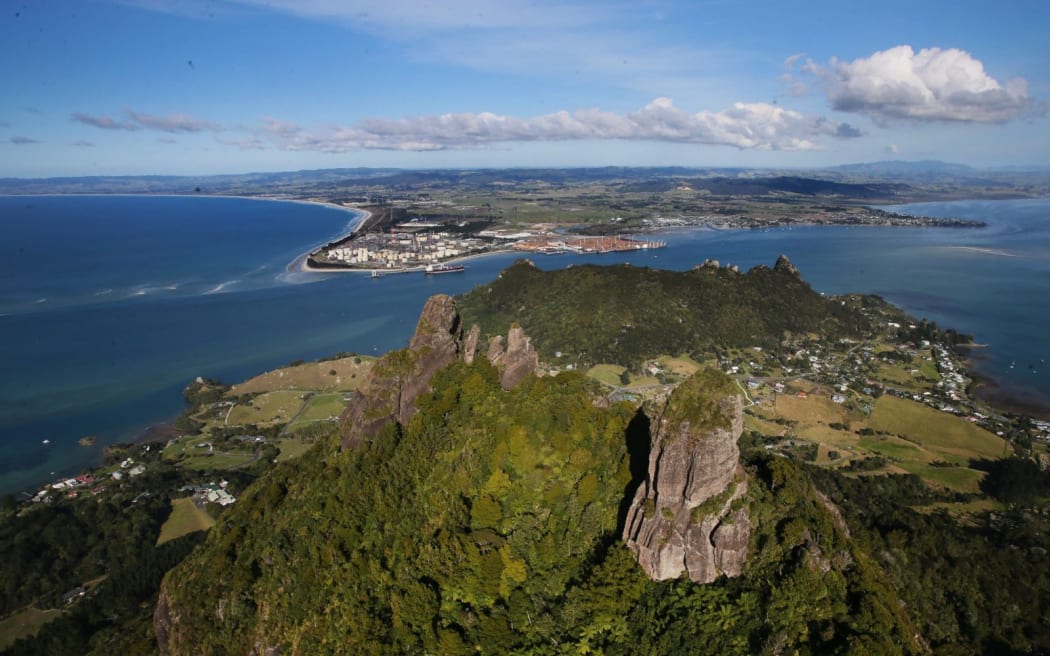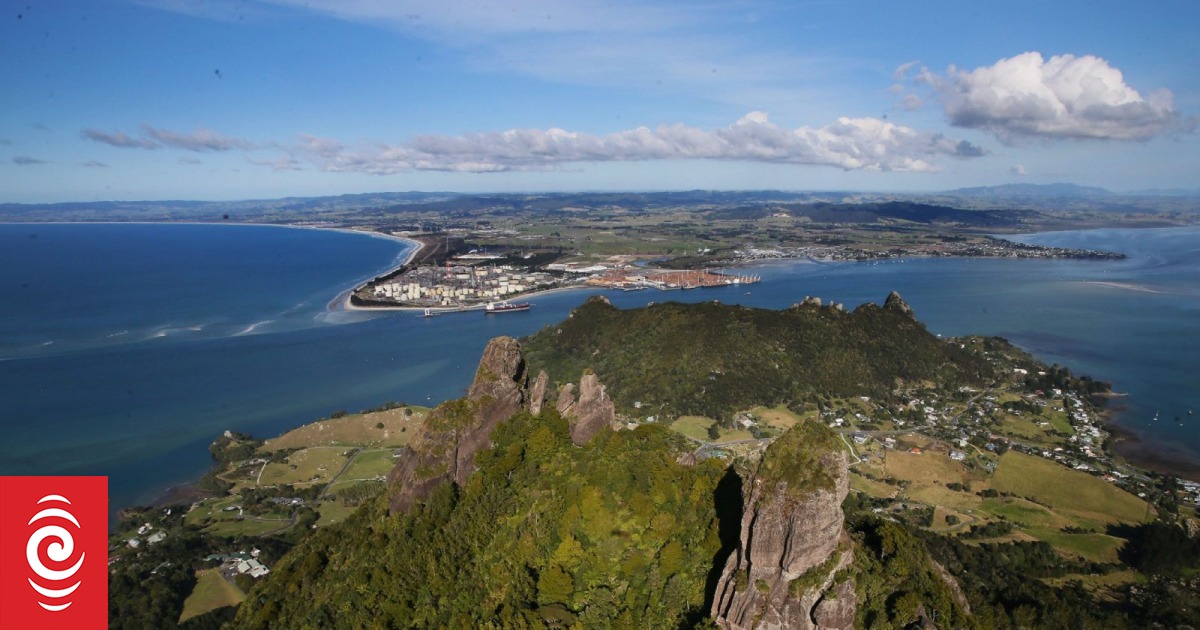
Mount Manaia watches over the entrance to at-risk Whangārei Harbour, less than 100 kilometres from new invasive super spreader seaweed on Great Barrier Island.
Photo: Northern Acvocate / Tania Whyte
In the serene embrace of Whangārei Harbour lies the ancestral legacy of hapū Te Parawhau.
For centuries, the hapu has nurtured a profound connection with the ocean, weaving tales of resilience, sustenance, and cultural significance into its waters.
However, in more recent times, the tranquil rhythms of tradition have been disrupted by the march of industrial progress, such as the Marsden Point Oil Refinery.
Now, testimonies from tangata whenua, concerned about future developments at the harbour, are being heard in a landmark case under the Marine and Coastal Area Act (MACA) in the Whangārei Māori Land Court.
Evidence has been given before Judge Lane Harvey from Te Parawhau members seeking a customary marine title (CMT) for rights across Whangārei Harbour.
If granted, the order would give hapū a voice when it came to new developments, planning documents for the area, granting mineral rights and the designation of sacred sites, where public access may be restricted.
Testimonies were given by hapū members Taipari Munro, Opania George, Margaret Kay, Riripete Mira Norris, Marina Fletcher, Auriole Ruka and others on the reality of environmental degradation faced by Te Parawhau.
Te Parawhau is one of the dominant Whangārei hapū and is sandwiched between Ngāpuhi from the North and Ngāti Whātua from the South.
Of the roughly 275,000 hectares previously owned by multiple Whangārei hapū pre-colonisation, less than 20,000 hectares remain with them.
Te Parawhau holds around Whangārei include Kauika, Maunu, Parihaka, Ōtaika, Toe Toe and across the harbour to Onerahi and their close marital connections to neighbouring iwi make them almost intangible.
Through the 1800s, Te Parawhau was led by tribal leader Te Tirarau Kūkupa who signed the Declaration of Independence in 1835 and then Te Tiriti in 1840.
Te Tirarau was involved in multiple Whangarei and Kaipara land sales, which the Native Land Court records his people supported at the time.
Te Tirarau was known for his peace-making abilities, often trading land to spare the lives of his tribe going to war or preventing passage through his territories to other tribes, effectively preventing conflict from spreading. He was described as a “tall, commanding figure with a countenance, very expressive”.
Much of the MACA case has hung on the difference between cultural interests and cultural rights and the ability to prove your group has used the area without substantial interruption since 1840.
“In my opinion, it’s the Whangārei tribes and especially those who live around the harbour who have the mana rangatira of the Moana, of Te Rerenga Parāoa,” Taipari Munro said in evidence.
“But we are also closely related and affiliated to major tribes around us, including Ngāti Whātua, Ngātiwai and Ngāpuhi. Ngāpuhi has a strong interest in the harbour in that Manaia is one of the posts of the sacred house of Ngāpuhi.
“But does that interest look the same, for example, as Takahiwai’s interest?” Munro asked the court.

Photo: Northern Advocate / Tania Whyte
As industrial juggernauts Northport and Marsden Cove Canals carved their presence into the landscape, the fabric of Te Parawhau’s traditional life in the moana began to fray.
Mere Kepa said in evidence, that when construction on the New Zealand Oil Refinery began in 1963, they believed the companies would be allies.
“For the hapū of Te Parawhau and Patuharakeke, our lives changed in 1963 and has never got better since,” Kepa said about the establishment of the oil refinery.
“We thought they were our friends,” Kepa recalled.
Before construction, the site was abundant with kōkota, a sweet flat pipi with an orange body, and an ample food resource for the locals.
However, by 1987 adverse effects were being felt by the environment and kōkota were dying off.
Kepa told the court that by the year 2000, the development of berths at Northport and subsequent activities significantly diminished access to kaimoana and disrupted the purity of the surrounding sea.
“With Marsden Cove development of luxury housing, that excluded Māori based on race, excluded our access to kaimoana, to our language, to our culture, to our gods. Northport has done the same. Refining New Zealand has done the same.
“That’s who we are, Parawhau hapū – landless, foodless, cultureless but not hopeless,” Kepa said in evidence.
Juliet Golightly, lawyer for Northport and Marsden Cove Canal, asked multiple witnesses how their developments affected the ability to undertake cultural activities in Marsden Bay.
“I have to go to the coast. It’s not that much cleaner because it is green and I understand that green is a sign of acidification and heating, but it is certainly cleaner than the harbour,” Kepa responded.
Mira Norris said access to the area had been significantly restricted.
“You do not indulge with all of us on the impacts that have happened to us and no one has also taken notice to compensate us for the huge loss,” Norris told Golightly.
Colin Lowe said they could no longer fish there.
“That’s the problem.”
Marina Fletcher expressed the aspiration of Te Parawhau to eventually have representation on the board of directors for developments at Northport.
“We live in hope … there are benefits with having the port here and I’m strongly for the port being here … It wants to be part of the development, ” Fletcher said.
Pari Walker told the court he believed it was unfair the hapū were having to go through the MACA legislation which superseded tikanga and whanaungatanga.
“I’m not too keen on the way that the MACA legislation would work, and I always will be against that, but I am quite confident in the tikanga of our people when it comes to managing this harbour,” Walker said.
The MACA was passed under John Key’s National Government in 2011 in response to Labour’s controversial Foreshore and Seabed Act of 2004, which in turn followed a 2003 Court of Appeal ruling that Māori customary rights to the foreshore and seabed had not been extinguished.
It provided for the recognition of Māori customary rights in parts of the marine and coastal area that aren’t already in private ownership or part of a conservation area.
Under the current law, an iwi or hapū applicant group has to meet two main criteria before the customary title is recognised.
It has to hold the area in accordance with Māori customs and practices and to have exclusively used and occupied the area since 1840, without substantial interruption.
The hearings continue in the Whangārei Māori Land Court.
-This story originally appeared in the New Zealand Herald





